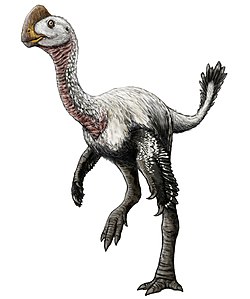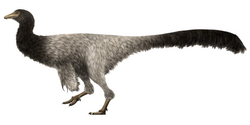1981 in paleontology
 From Wikipedia - Reading time: 10 min
From Wikipedia - Reading time: 10 min
| List of years in paleontology |
|---|
| (table) |
Paleontology or palaeontology is the study of prehistoric life forms on Earth through the examination of plant and animal fossils.[1] This includes the study of body fossils, tracks (ichnites), burrows, cast-off parts, fossilised feces (coprolites), palynomorphs and chemical residues. Because humans have encountered fossils for millennia, paleontology has a long history both before and after becoming formalized as a science. This article records significant discoveries and events related to paleontology that occurred or were published in the year 1981.
Plants
[edit]Angiosperms
[edit]Superrosids - Fabids
[edit]| Name | Novelty | Status | Authors | Age | Unit | Location | Synonymized taxa | Notes | Images |
|---|---|---|---|---|---|---|---|---|---|
|
Sp nov |
Valid |
Crane |
A betulaceous fruit. |
||||||
|
Gen et sp nov |
Valid |
Smiley & Huggins |
Latah Formation |
A fagaceous genus |
Arthropoda
[edit]Insects
[edit]| Name | Novelty | Status | Authors | Age | Unit | Location | Notes | Images |
|---|---|---|---|---|---|---|---|---|
|
Gen et sp. nov |
jr synonym |
An Amblyoponin ant. jr synonym of Casaleia inversa |
Reptilia
[edit]Early reptiles
[edit]| Taxon | Novelty | Status | Author(s) | Age | Unit | Location | Notes | Images | |
|---|---|---|---|---|---|---|---|---|---|
| Claudiosaurus germaini[5] | Gen. et sp. nov. | Valid | Carroll | Late Permian | Lower Sakamena Formation | An early neodiapsid | 
| ||
| Thadeosaurus colcanapi[5] | Gen. et sp. nov. | Valid | Carroll | Late Permian | Lower Sakamena Formation | An early neodiapsid | 
|
Archosauromorpha
[edit]Dinosaurs
[edit]Birds
[edit]- Palaeopteryx thomsoni Jensen, 1981 is most likely not a bird but rather a small non-avian dinosaur.
- Plegadis pharangites Olson, 1981 is a new name for Plegadis gracilis Miller et Bowman, 1956, preoccupied by Plegadis gracilis (Lydekker, 1891), described as Milnea gracilis Lydekker, 1891 and transferred to the genus Plegadis Kaup, 1829 by Cheneval, 1984.
| Name | Status | Novelty | Authors | Age | Unit | Location | Notes | Images |
|---|---|---|---|---|---|---|---|---|
|
Valid |
Sp. nov. |
Middle Sheep Creek Formation |
|
A Burhinidae. |
||||
|
Valid |
Gen. nov. et Sp. nov. |
An Enantiornithes Walker, 1981, Alexornithiformes Brodkorb, 1976, Enantiornithidae Nessov et Borkin, 1983, this is the type species of the new genus. |
||||||
|
Valid |
Sp. nov. |
Middle-Late Eocene |
A Gruiformes, Eogruidae Wetmore, 1934, this is the type species of the new genus. |
|||||
|
Valid |
Sp. nov. |
A Falconidae. |
||||||
|
Valid |
Sp. nov. |
A Gaviidae. |
||||||
|
Valid |
Gen. nov. et Sp. nov. |
Kvabebi |
An Otididae, this is the type species of the new genus. |
|||||
|
Valid |
Sp. nov. |
|
An Alcidae, Mancallinae L. H. Miller, 1946. |
|||||
|
Valid |
Gen. nov. et Sp. nov. |
A Sphniscidae, this is the type species of the new genus. Microdytes Simpson, 1981 is preoccupied by Microdytes Balfour-Browne, 1949 (Coleoptera), so Storrs L. Olson created the new genus Eretiscus Olson, 1986 to accommodate Microdytes tonnii Simpson, 1981.[21] |
||||||
|
Valid |
Gen. nov. et Sp. nov. |
Cave deposits |
A Fringillidae, Emberizinae, this is the type species of the new genus. |
|||||
|
Valid |
Sp. nov. |
Kuttipirra (Katipiri) Waterhole |
A Pelecanidae. |
|||||
|
Valid |
Sp. nov. |
A Picidae. |
||||||
|
Valid |
Gen. nov. et Sp. nov. |
A Gruiformes, Eogruidae Wetmore, 1934, this is the type species of the new genus. |
||||||
|
Valid |
Sp. nov. |
|
An Alcidae. |
|||||
|
Valid |
Sp. nov. |
A Gruiformes, Eogruidae Wetmore, 1934, transferred to the genus Amphipelargus Lydekker, 1891 by both Kurochkin, 1985 and Olson, 1985. |
||||||
|
Valid |
Sp. nov. |
A Gruiformes, Eogruidae Wetmore, 1934, transferred to the genus Amphipelargus Lydekker, 1891 by both Kurochkin, 1985 and Olson, 1985. |
||||||
|
Valid |
Gen. nov et Sp. nov. |
A Rallidae, this is the type species of the new genus. |
||||||
|
Valid |
Gen. nov et Sp. nov. |
Late Burdigalian, |
An Ardeidae, this is the type species of the new genus. |
Plesiosaurs
[edit]- Carroll, R. C., 1981, Plesiosaur ancestors from the Upper Permian of Madagascar: Philosophical Transactions of the Royal Society of London B, v. 293, p. 315- 383.
| Name | Status | Authors | Age | Unit | Location | Notes | Images | |
|---|---|---|---|---|---|---|---|---|
|
Valid |
Brown |
Late Jurassic (Kimmeridgian |
A cryptoclidid. |
|||||
Pterosaurs
[edit]New taxa
[edit]| Name | Status | Authors | Location | Images | |
|---|---|---|---|---|---|
|
Valid |
Galton |
||||
|
Valid |
Nesov |
||||
References
[edit]- ^ Gini-Newman, Garfield; Graham, Elizabeth (2001). Echoes from the past: world history to the 16th century. Toronto: McGraw-Hill Ryerson Ltd. ISBN 9780070887398. OCLC 46769716.
- ^ Pigg, K.B.; Manchester S.R.; Wehr W.C. (2003). "Corylus, Carpinus, and Palaeocarpinus (Betulaceae) from the Middle Eocene Klondike Mountain and Allenby Formations of Northwestern North America". International Journal of Plant Sciences. 164 (5): 807–822. doi:10.1086/376816. S2CID 19802370.
- ^ Smiley, C.J.; Huggins, L.M. (1981). "Pseudofagus idahoensis, n. gen. et sp. (Fagaceae) from the Miocene Clarkia flora of Idaho". American Journal of Botany. 68 (6): 741–761. ISSN 0002-9122.
- ^ Dlussky, G.M.; Putyatina, T.S. (2014). "Early Miocene ants (Hymenoptera, Formicidae) from Radoboj, Croatia". Neues Jahrbuch für Geologie und Paläontologie - Abhandlungen. 272 (3): 237–285. CiteSeerX 10.1.1.692.9292. doi:10.1127/0077-7749/2014/0409.
- ^ a b Carroll, R. L.; Westoll, Thomas Stanley (1981-07-16). "Plesiosaur ancestors from the Upper Permian of Madagascar". Philosophical Transactions of the Royal Society of London. B, Biological Sciences. 293 (1066): 315–383. doi:10.1098/rstb.1981.0079.
- ^ Kurzanov, S.M. 1981. On the unusual theropods from the Upper Cretaceous of Mongolia. Sovm. Sov.-Mong. Paleontol. Eksped. Trudy 15: pp. 39-50.
- ^ Maryanska, T. and H. Osmólska. 1981. First lambeosaurine dinosaur from the Nemegt Formation, Upper Cretaceous, Mongolia. Acta Palaeontologica Polonica. 26 (3-4): pp. 243-255.
- ^ Osmolska, H. 1981. Coosified tarsometatarsal in theropod dinosaurs and their bearing on the problem of bird origins. Paleontol. Polonica 42: pp. 79-95.
- ^ a b Barsbold, R. 1981. The toothless carnivorous dinosaurs of Mongolia. Sovm. Sov.-Mong. Paleontol. Eksped. Trudy 15: pp. 28-39.
- ^ Morris, W.J. (1981). "A new species of hadrosaurian dinosaur from the Upper Cretaceous of Baja California: ?Lambeosaurus laticaudus". Journal of Paleontology. 55 (2): 453–462. JSTOR 1304231.
- ^ Bartholomai, A., and R.E. Molnar. 1981. Muttaburrasaurus, a new iguanodontid (Ornithischia: Ornithopoda) dinosaur from the Lower Cretaceous of Queensland. Mem. Queensland Museum 20: pp. 319-149.
- ^ Jensen, J.A. 1981. Another look at Archaeopteryx as the world's oldest bird. Encyclia 58: pp. 109-128.
- ^ Colbert, E.H. 1981. A primitive ornithischian dinosaur from the Kayenta Formation of Arizona. Museum Northern Arizona Bull. 53: pp. 1-61.
- ^ K. Jeffrey Bickart (1981). "A New Thick-knee, Burhinus, from the Miocene of Nebraska, with Comments on the Habitat Requirements of the Burhinidae (Aves: Charadriiformes)". Journal of Vertebrate Paleontology. 1 (3–4): 273–277. doi:10.1080/02724634.1981.10011902.
- ^ Cyril A. Walker (1981). "New Subclass of Birds from the Cretaceous of South America". Nature. 292 (5818): 51–53. doi:10.1038/292051a0. S2CID 4340858.
- ^ a b c d Evgeny N. Kurochkin (1981). "[New Representatives and Evolution of Two Archaic Gruiform Families in Eurasia]". Sovmestnaja Sovetsko-Mongol'skaja Paleontol. Ekspedit. 15: 59–85.
- ^ a b A. S. Umanskaya (1981). "[Miocene Birds of the Black Sea Coastal Region]". Vestnik Zoologii Nauchnyy Zhurnal Instituta Zoologii Imeni I. I. Shmal'gauzena Akademii Nauk Ukrainskoy SSR II 3. 15: 17–21.
- ^ Nikolay I. Burchak-Abramovich & Abesalom K. Vekua (1981). "Fossil Bustard Runner Ioriotis gabunii New Genus New Species of East Georgian SSR USSR Akchagylian". Izvestiya Akademii Nauk Gruzinskoi SSR Seriya Biologicheskaya. 7: 53–60.
- ^ Storrs L. Olson (1981). "A Third Species of Mancalla from the Late Pliocene San Diego Formation of California (Aves: Alcidae)" (PDF). Journal of Vertebrate Paleontology. 1 (1): 97–99. CiteSeerX 10.1.1.614.8039. doi:10.1080/02724634.1981.10011882.
- ^ George G. Simpson (1981). "Notes on Some Fossil Penguins, including a New Genus from Patagonia". Ameghiniana. 18 (3–4): 266–272.
- ^ Storrs L. Olson (1986). "A Replacement Name for the Fossil Penguin Microdytes Simpson (Aves: Spheniscidae)". Journal of Paleontology. 60 (3): 785. doi:10.1017/S0022336000022332. S2CID 140620588.
- ^ Storrs L. Olson & Mary C. McKitrick (1981). "A New Genus and Species of Emberizine Finch from the Pleistocene Cave Deposits in Puerto Rico (Aves: Passeriformes)" (PDF). Journal of Vertebrate Paleontology. 1 (3–4): 279–283. CiteSeerX 10.1.1.501.5247. doi:10.1080/02724634.1981.10011903.
- ^ Patricia Vickers Rich & Gerard F. Van Tets (1981). "The Fossil Pelecans of Australasia". Records of the South Australian Museum. 18: 235–264.
- ^ A. S. Umanskaja (1981). "[Miocene Birds of the Black Sea Coastal Region]". Vestnik Zoologii Nauchnyy Zhurnal Instituta Zoologii Imeni I. I. Shmal'gauzena Akademii Nauk Ukrainskoy SSR II. 3: 17–21.
- ^ Hildegarde Howard (1981). "A New Species of Murre, Genus Uria, from the Late Miocene of California" (PDF). Bulletin of the Southern California Academy of Sciences. 80: 1–12. Archived from the original (PDF) on 2014-09-05.
- ^ Yeh Hsiangk’uei (1981). "[Third Note on Fossil Birds from Linqu, Shandong]" (PDF). Vertebrata PalAsiatica. 19 (2): 149–155.
- ^ Jean Chr. Balouet (1981). "Zeltornis ginsburgi n.g. n.sp. (Ardeidae: Aves), Héron Géant du Miocène Inférieur du Djebel Zelten (Libye)". Comptes Rendus de l'Académie des Sciences de Paris. Série II. 293: 235–239.
 KSF
KSF





